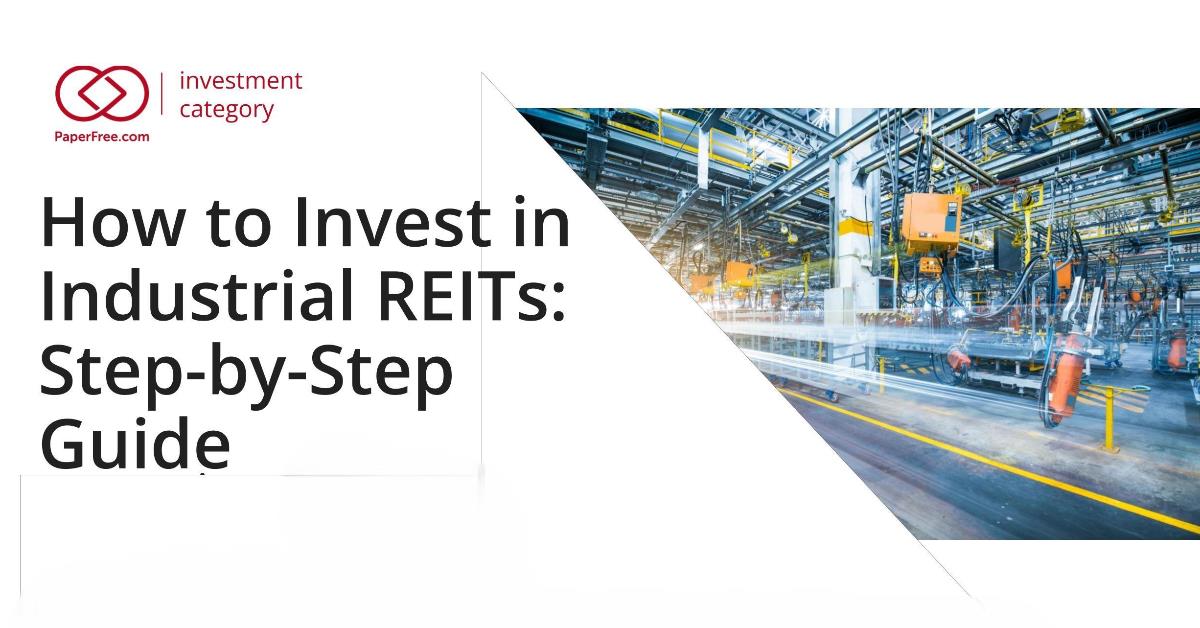How to Invest in Industrial REITs: Step-by-Step Guide 2025
Industrial real estate investment properties offer investors a reliable and efficient means of generating a consistent income stream.last updated Thursday, September 11, 2025
#how to invest in industrial real estate #Industrial REITs
| | by John Burson | Content Manager, Paperfree Magazine |

QUICK LINKS
AD
Get Access to Real Estate Investment Opportunities
Industrial Real Estate Investment Trusts (REITs) or industrial real estate funds are becoming a popular choice for investors who want to gain exposure to the booming warehouse and logistics sector without the significant capital required for direct property investment. With the continued growth of e-commerce, supply chains, and urbanization, industrial REITs offer promising returns with dividend yields of around 3.21%.
Investing in industrial real estate or the best industrial warehouse REITs allows you to benefit from this lucrative market with as little as $100. The process is accessible and manageable, making it an excellent entry point for beginners. In this comprehensive guide, we’ll walk you through everything you need to know about industrial REITs and how to start investing in 2025.
Ready to learn how to invest in industrial real estate? This actionable guide walks you through exactly how to buy industrial REITs, compare top options, and build a profitable portfolio without the complexities of direct property ownership.
What Are Industrial REITs?
Industrial REITs are companies that own, operate, or finance income-producing properties in the industrial real estate sector. These properties mainly consist of warehouses, distribution centers, and logistics facilities that support e-commerce, manufacturing, and supply chain operations.
Key Benefits of Industrial REITs:
- Diversification
Industrial REITs provide exposure to a diverse portfolio of properties and markets, thereby reducing risk. - Steady Income
REITs typically pay high dividends, offering a reliable income stream for investors. - Growth Potential
The industrial real estate sector has experienced robust growth, primarily driven by the rise of e-commerce and the expansion of global supply chains.
Step 1: Choosing the Right Investment Platform
Before investing in industrial REITs, select a brokerage platform that aligns with your investment style.
Best Brokerages for REIT Investing
| Brokerage | Key Features | Best For |
|---|---|---|
| Charles Schwab | Zero-commission trades, extensive REIT research tools | Research-driven investors |
| Fidelity | No account minimums, excellent REIT screening tools | Beginners with no minimum investment |
| Vanguard | Low-cost index funds and ETFs with REIT exposure | Cost-conscious investors |
| TD Ameritrade | Advanced charting and analysis tools | Active traders looking for detailed insights |
| Interactive Brokers | Professional-grade platform with global access | International investors and professionals |
What to Look For:
- Commission-Free Trades
Helps keep costs low. - Research Tools
Strong REIT screening capabilities to compare potential investments. - Dividend Reinvestment Plans (DRIPs)
Allow for the automatic reinvestment of dividends, facilitating compounding growth. - Mobile Access
Monitor your portfolio on the go with an app.
AD. Explore Top Investment Platforms for REITs – This link offers a comprehensive overview of the best platforms for investing in REITs.
Step 2: Top Industrial REITs to Consider
When investing in industrial REITs, it's essential to choose high-quality companies that offer stable returns. Below are some top REITs to consider for 2025.
| REIT | Market Cap | Dividend Yield | Investment Focus | Best For |
|---|---|---|---|---|
| Prologis (PLD) | $135+ billion | 2.8% | Global logistics facilities | Conservative investors seeking stability |
| EastGroup Properties (EGP) | $8+ billion | 3.1% | Development in high-growth markets | Growth-focused investors |
| STAG Industrial (STAG) | $7+ billion | 4.2% | Single-tenant properties | Income-focused investors |
| Plymouth Industrial REIT (PLYM) | Smaller cap | 5.6% | Secondary and tertiary markets | High-yield seekers |
| LXP Industrial Trust (LXP) | Smaller cap | 5.7% | Value-oriented acquisition approach | Risk-tolerant investors |
- Prologis: The Market Leader
Prologis is the dominant player in the industrial REIT space, with a portfolio of 5,500+ logistics facilities worldwide. It serves top-tier tenants, including Amazon and FedEx. - EastGroup Properties: Sunbelt Specialist
EastGroup focuses on high-growth markets, especially in the southern U.S. It specializes in last-mile distribution centers, benefiting from the continued rise of e-commerce. - STAG Industrial: Value Play
STAG focuses on single-tenant properties and offers an attractive dividend yield of 4.2%. It's a great option for income-focused investors.
Step 3: Individual REITs vs. REIT ETFs
When investing in industrial REITs, you can choose between investing in individual REITs or REIT ETFs.
Individual Industrial REITs
- Pros:
- More control over specific investments.
- Potential for higher returns with stock picking.
- Cons:
- Requires in-depth research and monitoring.
- Less diversification compared to ETFs.
Industrial REIT ETFs
ETFs offer exposure to a diversified portfolio of industrial REITs, which reduces risk.
| ETF | Expense Ratio | Industrial REIT Exposure | Best For |
|---|---|---|---|
| Vanguard Real Estate ETF (VNQ) | 0.12% | ~25% | Broad diversification at a low cost |
| iShares Cohen & Steers REIT ETF (ICF) | 0.34% | Concentrated holdings in top performers | Active management, quality focus |
| Invesco KBW Premium Yield Equity REIT ETF (KBWY) | 0.35% | High-yield focus | Income-seeking investors |
AD. What is the Difference Between REITs and ETFs? – Learn more about the difference between individual REITs and ETFs.
Step 4: How to Make Your First REIT Purchase
- Log In to Your Brokerage Account
Ensure you have a verified account with commission-free trading capabilities. - Search for Your Chosen REIT Ticker
Example: "PLD" for Prologis or "EGP" for EastGroup Properties. - Review the Price and Key Metrics
Check current price, market cap, and dividend yield. - Choose Your Order Type:
- Market Order: Executes at the current price.
- Limit Order: Set a price you’re willing to pay.
- Dollar-Cost Averaging: Set up automatic purchases to spread your buying cost over time.
Sample Portfolio for Beginners:
- 40% Prologis (PLD): $2,000
- 30% EastGroup Properties (EGP): $1,500
- 20% STAG Industrial (STAG): $1,000
- 10% Vanguard Real Estate ETF (VNQ): $500
Step 5: Dividend Reinvestment Plans (DRIPs)
DRIPs allow you to reinvest dividends automatically into more shares of your REITs, compounding your returns over time.
Benefits of DRIPs:
- Automatic Compounding
Grow your investment faster without transaction fees. - Cost-Efficient
No brokerage fees or commissions.
Alternatively, manual reinvestment provides more control, particularly for tax planning purposes.
Step 6: Monitoring and Optimizing Your Portfolio
Investing in REITs requires regular monitoring to ensure your portfolio is on track.
Key Metrics to Track:
- Funds From Operations (FFO)
Measures a REIT’s profitability. - Occupancy Rates
Indicates how much space is leased in the REIT’s properties. - Debt-to-Equity Ratio
Indicates financial stability. - Net Asset Value (NAV)
Helps assess whether a REIT is undervalued.
AD. Learn How to Monitor REIT Performance – Learn more about how to evaluate a REIT’s performance.
Step 7: Advanced Investment Strategies
- Sector Rotation
Focus on last-mile distribution REITs and cold storage REITs, which are in high demand due to the growing e-commerce sector. - International Diversification
Explore REITs with global exposure, such as Prologis, which operates in multiple countries.
Step 8: Common Mistakes to Avoid
- Overconcentration
Limit your investment in any one REIT to 10-15% of your total portfolio. - Yield Chasing
High yields often signal potential risks. Focus on sustainable growth. - Ignoring Interest Rate Sensitivity
Be aware of interest rate changes, as they can impact REIT prices. - Neglecting Geographic Diversification
Diversify across different regions and markets to minimize risk.
Frequently Asked Questions
1. What is a REIT?
A Real Estate Investment Trust (REIT) is a company that owns, operates, or finances income-producing real estate.
2. How do I start investing in REITs?
Select a brokerage platform, research the top industrial REITs, and make your first investment. Consider dollar-cost averaging and dividend reinvestment for long-term growth.
3. Can I make money from industrial REITs?
Yes, industrial REITs typically offer consistent dividend income and the potential for capital appreciation.
4. What are the risks of investing in REITs?
Risks include market fluctuations, interest rate changes, and tenant default risk. Diversification across multiple REITs can help mitigate these risks.
For the best industrial real estate investment strategy, book your Free Discovery call for advanced portfolio management tools and expert guidance on building your industrial REIT portfolio. Paperfree's Investment Strategies offer real-time analysis, automated rebalancing, and tax-optimized strategies to help you maximize your returns. Begin your industrial REIT investment journey with professional support and cutting-edge tools.
Related Pages
- Real Estate Investing Basics: 2 Ways of Real Estate Investment

- Are REITs safe investment? REIT risks explained. Mortgage REIT risks.

- How do REITs work? How To Make Money On a REIT (Real Estate Investment Trust)?

- Investing in REITs vs Rental Property. Comparison Between Direct Real Estate Investment vs REITs.

- Equity REIT Vs Mortgage REIT

- REIT Valuation by FFO and AFFO

- Risks of investing into Private REIT vs Public REIT

- Warren Buffett Real Estate | Why Warren Buffet invest in real estate?

Popular Page
Private Real Estate Funds - Investments to Drive Income and Capital Growth
Book a Free Complimentary Call
Search within Paperfree.com
real estate investing Investment Visa USA Investment Magazine Private Real Estate Funds real estate funds
